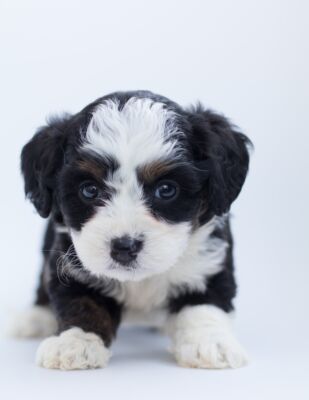Bernedoodles vs Goldendoodles, do you know which one you prefer? Bernedoodles and Goldendoodles are both popular hybrid dog breeds. The Bernedoodle is created by crossing a Poodle with a Bernese Mountain Dog, whereas the Goldendoodle is created by crossing a Golden Retriever and a Poodle.

While they may share some similarities, they also have several differences in terms of their origins, coat types, size, and temperament.
If you are in the market for either a Bernedoodle or a Goldendoodle, this blog will help you decide what choice might be better for you, your needs, and your family.
The History Behind The Bernese Mountain Dog & Golden Retriever
Bernese Mountain Dogs (nicknamed Berners) are large, working dogs that originated in Switzerland around the city of Berne (hence the name) and were historically used as farm dogs who would pull carts and drive cattle. They have an aesthetically pleasing tricolored coat and are more of a laid-back breed that only requires about 30 minutes of exercise per day.
Golden Retrievers are medium to large-sized gun dogs that originated in Scotland and were bred for retrieving wild game. Golden Retrievers are known for their affectionate nature and are great dogs for families with young children. This breed makes great service dogs, alongside Labrador Retrievers.
Bernedoodle VS Goldendoodle Coats & Grooming
Bernedoodles and Goldendoodles can have different types of coats, depending on their parent breeds and how their coats are expressed. Although similar, coats can vary from animal to animal of the same breed, so this is key to keep in mind when understanding what a coat might look like after crossing them.

Bernedoodles typically have a thick, wavy, or curly coat that is often tricolor, with black, white, and brown markings. Bernedoodles have a plush coat that is great insulation against the elements, and although coat type may vary from dog to dog, they typically need to be groomed often falling under the “moderate” category for grooming needs. Since Bernese Mountain Dogs do have fur and breeders are looking to replace it with the poodle’s hypoallergenic hair, it is quite a difficult process to get a non-shedding tricolored dog. It can be done, but it will likely take many generations of breeding and will be the most expensive version of the dog. This means that the most common Bernedoodles are bi-colored.
Goldendoodles, on the other hand, can have a straight, wavy, or curly coat that is usually gold, cream, or red in color. Goldendoodles can have flat coats, which is more common in the F2 generation, and which has, as the name suggests, a flatter, longer appearance.
Curly or wavy Goldendoodle coats are the most popular and can require less brushing, but much like their Bernedoodle counterparts, require a moderate amount of brushing overall.
There are a wide variety of Goldendoodles which can be boiled down to how proficient the breeder is. If a breeder successfully breeds a Goldendoodle with poodle hair instead of the Golden Retriever’s fur, that will result in dogs that don’t shed and who have curly coats. Flat or straight coats are from earlier generations and will likely still shed, although not quite as much as a Golden Retriever would.
Bernedoodle VS Goldendoodle Temperament
Both Bernedoodles and Goldendoodles are generally known for their friendly and social personalities. They are typically affectionate, intelligent, and eager to please.
Bernedoodles may inherit some of the Bernese Mountain Dog’s calm, sweet, and laid-back nature, while Goldendoodles may inherit the Golden Retriever’s outgoing and playful personality.
Both Bernedoodles & Goldendoodles are intelligent and goofy and love to entertain young children for hours.
Bernedoodle VS Goldendoodle Size
Both Bernedoodles and Goldendoodles can come in different sizes, depending on the size of their Poodle parent. They can be mini, medium, or standard-sized dogs, with varying weights and heights.
Standard Bernedoodles are typically the bigger of the two with Bernedoodles reaching anywhere from 60 – 100 lbs in weight versus the Standard Goldendoodle, which falls between 50 and 70 lbs. This could also be why Goldendoodles are popular as they are the perfect size for a smaller home or even an apartment.
Mini Bernedoodles and Goldendoodles are very popular and range from 10 to 40 pounds. Doodles are listed as “medium” if their adult weight is anywhere between 35 to 55 pounds. As you can see there is some overlap in the sizes. Animals and dogs are unique and even the same litter can have size variations amongst them!
Bernedoodle or Goldendoodle? The Choice Is Yours!
While Bernedoodles and Goldendoodles may have some similarities in terms of their affectionate personalities and low-shedding coats, they also have differences in terms of their origins, coat types, temperaments, and sizes. You should keep in mind your lifestyle, the size of your home, the presence of a backyard, and various other details before purchasing.
So what doodle is more appropriate for you?
Looking for your forever fur friend? Explore our adorable Goldendoodles and some of our expertly trained puppies here: https://www.prideandprejudoodles.com/
